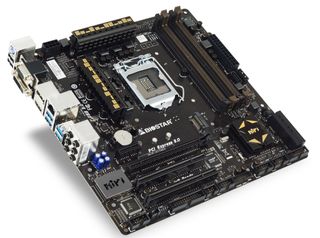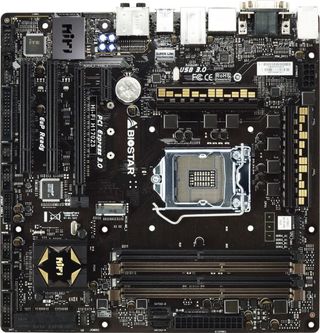Dual DIMM Support: Biostar's Hi-Fi H170Z3 Offers Both DDR3 And DDR4

Intel's 6th Generation Core Processors (Skylake) launched this summer, and the new processors bring DDR4 into the mainstream PC market, which means higher up front cost when upgrading from a previous platform. Although DDR4 is faster, there's nothing really wrong with DDR3 at this point, and having the option to switch platforms one step at a time will be an enticing option for many people looking to upgrade.
Biostar recognized this market and took it one step further with the creation of the Hi-Fi H170Z3. This board not only supports both DDR3 and DDR4, it manages to do so in a compact Micro ATX form factor. The company has split the four available DIMM slots into pairs of DDR3 and DDR4 slots. This will limit the maximum memory capacity, but you can still install a healthy 16 GB of DDR3 or 32 GB of DDR4.

In addition to supporting two types of memory, Biostar has included a Gen3x4 M.2 socket with room for 30 mm, 42 mm, 60 mm and 80 mm M.2 cards. The Gen3x4 socket can operate at up to 32 Gb/s, which is over three times faster than Gen2x2 sockets. The Hi-Fi H170Z3 also includes one SATA Express port for multiple fast storage options.
Intel's H170 chipset is designed to be used with locked Core processors, and as such they have the ability to enable the iGPU found in many of Intel's processors. Biostar has opted to enable it with this board, and has included a DVI, HDMI, Display Port and even a legacy VGA port. The company said the board supports 4k displays, as well as triple display setups without a discrete GPU.
The mATX motherboard features Biostar's shielded audio solution, which it calls "Hi-Fi." Hi-Fi is a combination of amplifier hardware, independent power, segregated circuitry and a software solution with multi-channel calibration. Biostar said these features help reduce electronic noise.

Biostar has included a number of features that should aid in the longevity of the H170Z3. The company installed Super Durable solid state capacitors rated for 10k hours, and low resistance MOSFET with eight pins instead of the tradition three. Biostar claimed this helps reduce the operational temperature, which should increase its lifespan.
The board also features Super LAN Surge Protection, which is a chip that is designed to strengthen electrical stability, and help prevent damage caused from an electrical surge through the network cable. All of these features are installed onto a moisture-proof PCB, making it ideal for harsh environments, or coastal locations.
Stay on the Cutting Edge
Join the experts who read Tom's Hardware for the inside track on enthusiast PC tech news — and have for over 25 years. We'll send breaking news and in-depth reviews of CPUs, GPUs, AI, maker hardware and more straight to your inbox.
Biostar's Hi-Fi H170Z3 mATX motherboard is available now for a suggested price of $104.99.
Follow Kevin Carbotte @pumcypuhoy. Follow us @tomshardware, on Facebook and on Google+.
Kevin Carbotte is a contributing writer for Tom's Hardware who primarily covers VR and AR hardware. He has been writing for us for more than four years.
-
TechyInAZ Looks nice! Glad they have this feature!Reply
Reminds me of the old days when there were DDR3 and DDR2 dims on the same motherboard. -
Chiara2012 Awesome..Reply
Now we will see ddr3 vs ddr4 tests with Intel's 6th gen processors.
Hurry up guys! -
jimmysmitty Reply16626249 said:Looks nice! Glad they have this feature!
Reminds me of the old days when there were DDR3 and DDR2 dims on the same motherboard.
This is pretty common for Intel, in fact they have done this with every DDR change (there were DDR1&2 boards, DDR2&3 boards). It only makes sense considering that DDR4 is still expensive and since this is their mainstream market, probably one of their top selling consumer markets, it only makes sense to cover the broadest range of consumers out there as most people who don;t care about the cost for DDR4 went to it with Haswell-E.
That said, I am wondering if there needs to be a correction to the article. Everything we have been presented with was saying Skylake supports DDR3L which means not all current DDR3 will be supported. -
Sakkura PCIe 3.0 x4 is 4 times the bandwidth of 2.0 x2, so "over 3 times" is a slightly silly description.Reply
Oh, and as for DDR3L, that's just DDR3 at 1.35V. Most 1.5V kits should work, but perhaps at lower than rated clocks. -
kcarbotte Reply16628231 said:PCIe 3.0 x4 is 4 times the bandwidth of 2.0 x2, so "over 3 times" is a slightly silly description.
Oh, and as for DDR3L, that's just DDR3 at 1.35V. Most 1.5V kits should work, but perhaps at lower than rated clocks.
maximum throughput for Gen2x2 M.2 is 10Gb/s
maximum throughput for Gen3x4 M.2 is 32Gb/s -
alidan Reply16626249 said:Looks nice! Glad they have this feature!
Reminds me of the old days when there were DDR3 and DDR2 dims on the same motherboard.
This is pretty common for Intel, in fact they have done this with every DDR change (there were DDR1&2 boards, DDR2&3 boards). It only makes sense considering that DDR4 is still expensive and since this is their mainstream market, probably one of their top selling consumer markets, it only makes sense to cover the broadest range of consumers out there as most people who don;t care about the cost for DDR4 went to it with Haswell-E.
That said, I am wondering if there needs to be a correction to the article. Everything we have been presented with was saying Skylake supports DDR3L which means not all current DDR3 will be supported.
if you are building a 100% new system, as i will be due to being on ddr2, the price difference between 3 and 4 is negligible now, looking at 2 8gb sticks, ddr3 from gskill costs 75$ and ddr4 costs 110$ and when an overall system will cost you 600-2000 depending on parts, the 35$ difference on ram is negligible, id rather have have 4 ddr4 slots than 2 just for future upgrades when ddr4 does hit rock bottom price range, a ram disk used as scratch or for loading massive things while hooked up to battery backup would be awesome. -
Sakkura Reply16628517 said:16628231 said:PCIe 3.0 x4 is 4 times the bandwidth of 2.0 x2, so "over 3 times" is a slightly silly description.
Oh, and as for DDR3L, that's just DDR3 at 1.35V. Most 1.5V kits should work, but perhaps at lower than rated clocks.
maximum throughput for Gen2x2 M.2 is 10Gb/s
maximum throughput for Gen3x4 M.2 is 32Gb/s
Only if you're dumb enough to ignore overhead.
Maximum bandwidth of PCIe 2.0 x2 is 1 GB/s
Maximum bandwidth of PCIe 3.0 x4 is 4 GB/s (actually very slightly less, but that's a detail)
-
joex444 From the actual article above,Reply
> The Gen3x4 socket can operate at up to 32 Gb/s, which is over three times faster than Gen2x2 sockets.
Nowhere does it talk about PCIe 3.0 x4 vs PCIe 2.0 x2.
If you wanted to pick at nits, I'd've started with how "It's over three times *faster*" means that it's at least FOUR times as fast. It should be "The Gen3x4 socket can operate at up to 32Gb/s, which is more than three times as fast as Gen2x2 sockets." -
joex444 From the actual article above,Reply
> The Gen3x4 socket can operate at up to 32 Gb/s, which is over three times faster than Gen2x2 sockets.
Nowhere does it talk about PCIe 3.0 x4 vs PCIe 2.0 x2.
If you wanted to pick at nits, I'd've started with how "It's over three times *faster*" means that it's at least FOUR times as fast. It should be "The Gen3x4 socket can operate at up to 32Gb/s, which is more than three times as fast as Gen2x2 sockets." -
Sakkura Reply16632268 said:From the actual article above,
> The Gen3x4 socket can operate at up to 32 Gb/s, which is over three times faster than Gen2x2 sockets.
Nowhere does it talk about PCIe 3.0 x4 vs PCIe 2.0 x2.
If you wanted to pick at nits, I'd've started with how "It's over three times *faster*" means that it's at least FOUR times as fast. It should be "The Gen3x4 socket can operate at up to 32Gb/s, which is more than three times as fast as Gen2x2 sockets."
Gen3x4 and Gen2x2 means PCIe 3.0 x4 and PCIe 2.0 x2. In this case all delivered with the M.2 interface, but that doesn't matter for the bandwidth.
And again, the fact is that 3.0 x4 gives you ~4 times as much actual bandwidth. The higher overhead of PCIe 2.0 really shouldn't count in its favor.
Most Popular



